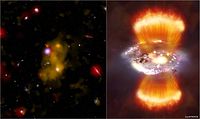| HCM-6A | |
|---|---|
 The composite image on the left shows one of the largest blobs observed in this study. Glowing hydrogen gas in the blob is shown by a Lyman-alpha optical image (colored yellow) from the National Astronomy Observatory of Japan's Subaru telescope. A galaxy located in the blob is visible in a broadband optical image (white) from the Hubble Space Telescope and an infrared image from the Spitzer Space Telescope (red). Finally, the Chandra X-ray Observatory image in blue shows evidence for a growing supermassive black hole in the center of the galaxy. Radiation and outflows from this active black hole are powerful enough to light up and heat the gas in the blob. Radiation and winds from rapid star formation occurring in the galaxy is believed to have similar effects. Clear evidence for four other active black holes in blobs is also seen. | |
| Observation data (J2000 epoch) | |
| Constellation | Cetus |
| Right ascension | 02h 39m 54.7s |
| Declination | −01° 33′ 32″ |
| Redshift | 6.56 |
| Distance | 12.8 billion light years (4.0 billion parsecs) (light travel distance) 28.2 billion light years (8.6 billion parsecs) (comoving distance) |
| Apparent magnitude (V) | 24.24 |
| Characteristics | |
| Type | LAE |
| Other designations | |
| HCB2010 J023954-013332 | |
HCM-6A is an LAE galaxy that was found in 2002 by Esther Hu and Lennox Cowie from the University of Hawaii and Richard McMahon from the University of Cambridge, using the Keck II Telescope in Hawaii. HCM-6A is located behind the Abell 370 galactic cluster, near M77[1] in the constellation Cetus, which enabled the astronomers to use Abell 370 as a gravitational lens to get a clearer image of the object.[2][3]
HCM-6A was the farthest object known at the time of its discovery. It exceeded SSA22−HCM1 (z = 5.74) as the most distant normal galaxy known, and quasar SDSSp J103027.10+052455.0 (z = 6.28) as the most distant object known. In 2003, SDF J132418.3+271455 (z = 6.578) was discovered, and took over the title of most remote object known, most remote galaxy known, and most remote normal galaxy known.
- ^ Halton Arp & David Russell (2001). "A Possible Relationship between Quasars and Clusters of Galaxies". The Astrophysical Journal. 549 (2): 802–819. Bibcode:2001ApJ...549..802A. doi:10.1086/319438. S2CID 120014695.
- ^ E. M. Hu, et al. (2001). "A Redshift z = 6.56 Galaxy behind the Cluster Abell 370". The Astrophysical Journal Letters. 568 (2): L75–L79. arXiv:astro-ph/0203091. Bibcode:2002ApJ...568L..75H. doi:10.1086/340424. S2CID 117047333.
- ^ Press release, National Astronomical Observatory of Japan, September 13, 2006